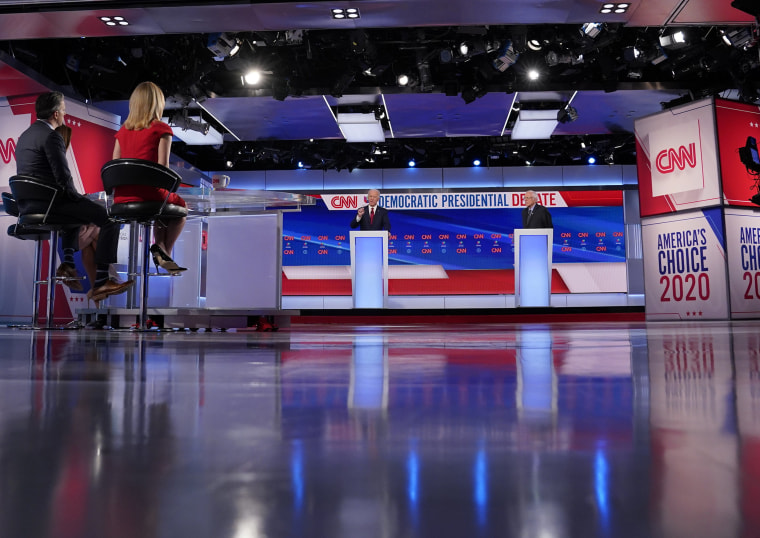WASHINGTON — If you deliver an applause line and there's no one around to clap, did it really land?
That was the question at Sunday night's debate on CNN between Bernie Sanders and Joe Biden when, because of fears of the coronavirus, there was no live audience to boo! or woo! when, say, the former vice president pledged to name a woman as his running mate.
The septuagenarian candidates started with an elbow bump in lieu of a handshake. And their podiums (highly sanitized, CNN assured ahead of time) were as far apart on the stage (also highly sanitized) as the candidates were on the issues.
It was also almost certainly the first presidential debate in history to include the sentences "I'm using a lot of soap" (Sanders) and "I wash my hands God knows how many times a day" (Biden).
It's stunning how much the world has changed in a matter of weeks since the last debate in South Carolina on Feb. 25, when there was no room for social distancing because seven candidates were on stage and it took 83 minutes for CBS' moderators to bring up the coronavirus, then a distant concern.
But the real innovation was what was missing Sunday night: a live audience.
"The candidates still naturally have the instinct to deliver applause lines at the end of their statements — but there's no one to applaud in CNN's studio," said Jared Leopold, the former communications director of Washington Gov. Jay Inslee's presidential campaign. "It's sort of like watching a show that usually has a laugh track but suddenly cuts it."
Judging by the overwhelmingly positive reaction to the no-audience faceoff, at least among political influencers on Twitter, Sunday's debate could be like NBC's "30 Rock," which helped kill the sitcom laugh track to fit in more substance, which in its case was jokes.
Since 1976, presidential debates in both the primary and general elections have included live audiences. Sometimes audience members offer questions, but more often than not they're there to ... well, it's not really clear.
"They don't really play a role," said Alan Schroeder, a professor at Northeastern University's School of Journalism in Boston and the author of "Presidential Debates: 50 Years of High-Risk TV."
"The lack of a studio audience gave the debate a slightly antiseptic feel," Schroeder said of Sunday's match, "but this worked to the candidates' advantage by keeping distractions to a minimum. The audience was not missed."
The audience in the room has never really been the one that mattered.
Even during the famous Lincoln-Douglas debates in 1858, long before television, while thousands watched Abraham Lincoln and Stephen Douglas face off over slavery, their biggest impact came two years later, when Lincoln published the debates in a book and rode their surprise success to the Republican Party's presidential nomination and then the White House.
Sunday's debate was a throwback to the very first televised presidential debates in 1960, when John F. Kennedy and Richard Nixon debated four times in empty TV studios but reached upward of 60 million people watching at home.
Download the NBC News app for breaking news and politics
Broadcasting a debate so revolutionary at the time required an act of Congress to waive the Equal Time Rule, a defunct mandate that required TV networks to treat candidates from opposing parties identically. And concern about the rule contributed to the addition of live audiences for future debates, because sponsors thought it made a debate look more like "a bona fide news event," which was granted an exception to the rule.
"Debates with audiences are just so overproduced and hyped as showdowns by the networks in a way that practically guarantees they are substance free," said Kevin Madden, a former senior adviser to Mitt Romney's 2012 presidential campaign.
"The pre-debate countdowns and audiences packed by campaigns only help contribute to a circuslike atmosphere," Madden added. "There's just more pressure to turn these into an entertainment event than an informational one."
In 2016, Donald Trump placed Juanita Broaddrick and Paula Jones in the audience, along with two other women who had accused Bill Clinton of sexual impropriety, to taunt Hillary Clinton at their second debate.
But live audience debates have had their moments.
One question in a town hall-format debate between President George H.W. Bush and Bill Clinton created two lasting moments when Bush checked his watch as if he couldn't wait for it to be over and walked right up to a woman asking a question and told her, "I feel your pain."
Philippe Reines, a former top aide to Hillary Clinton who played Trump in debate prep sessions with the former secretary of state, said the main thing missing Sunday night was the "sense of who is 'winning'" based on the feedback from the audience.
Next time, he said, the organizers should go even further. "For this to be a valid controlled experiment, the next debate should be without moderators," he said.
CORRECTION (March 15, 2020, 11:55 p.m. ET) An earlier version of this article misspelled the last name of a woman who accused Bill Clinton of sexual impropriety. She is Juanita Broaddrick, not Broderick.

